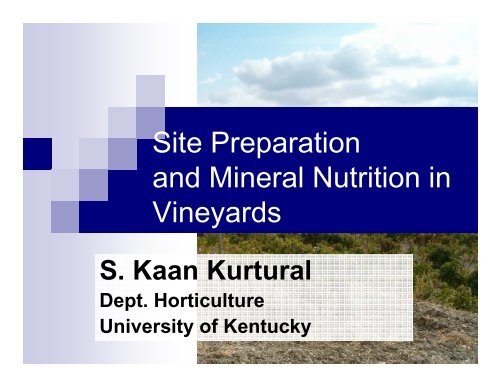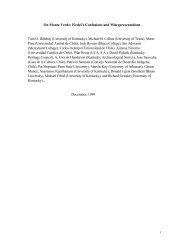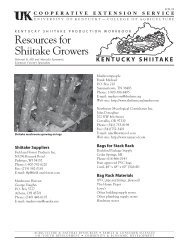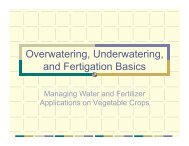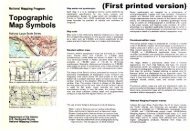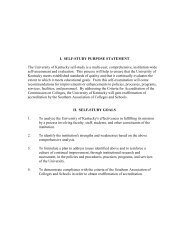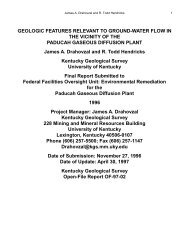Site Preparation and Mineral Nutrition in Vineyards - University of ...
Site Preparation and Mineral Nutrition in Vineyards - University of ...
Site Preparation and Mineral Nutrition in Vineyards - University of ...
Create successful ePaper yourself
Turn your PDF publications into a flip-book with our unique Google optimized e-Paper software.
<strong>Site</strong> <strong>Preparation</strong><br />
<strong>and</strong> <strong>M<strong>in</strong>eral</strong> <strong>Nutrition</strong> <strong>in</strong><br />
V<strong>in</strong>eyards<br />
S. Kaan Kurtural<br />
Dept. Horticulture<br />
<strong>University</strong> <strong>of</strong> Kentucky
V<strong>in</strong>eyard <strong>Nutrition</strong> Stages<br />
• <strong>Nutrition</strong> management is important dur<strong>in</strong>g<br />
3 phases:<br />
<strong>Site</strong> preparation<br />
V<strong>in</strong>e establishment<br />
Mature v<strong>in</strong>es
<strong>Site</strong> <strong>Preparation</strong>
<strong>Site</strong> preparation<br />
• One or two seasons before plant<strong>in</strong>g<br />
Weed control<br />
Soil test<strong>in</strong>g<br />
Nutrient/pH adjustment<br />
Tree/brush/rock removal<br />
Cultivation: sub-soil<strong>in</strong>g, plow<strong>in</strong>g, disk<strong>in</strong>g<br />
Cover crop establishment
V<strong>in</strong>eyard Design<br />
• Row orientation: across slope, parallel to<br />
prevail<strong>in</strong>g w<strong>in</strong>d; or north-south<br />
• Row spac<strong>in</strong>g: width <strong>of</strong> tractor <strong>and</strong> implements 9-<br />
12’<br />
• V<strong>in</strong>e spac<strong>in</strong>g: variety <strong>and</strong> site dependent, 6-8’<br />
• Row length: site dependent, common 300’<br />
• Headl<strong>and</strong>s & drive alleys: turn<strong>in</strong>g equipment 30<br />
– 40’
Plant<strong>in</strong>g Considerations<br />
• Order from reputable grapev<strong>in</strong>e nurseries<br />
• No <strong>of</strong> v<strong>in</strong>es/acre = 43,560 sq.ft/row’ x v<strong>in</strong>e<br />
spac<strong>in</strong>g’<br />
• Order early fall for spr<strong>in</strong>g plant<strong>in</strong>g<br />
• Plant <strong>in</strong> spr<strong>in</strong>g; soil temp >50F<br />
• M<strong>in</strong>imize root prun<strong>in</strong>g
Soil Test<strong>in</strong>g<br />
• Collect 10-20 sub-samples<br />
• at 0-8” (top soil) <strong>and</strong> 8-16” (sub soil) depth<br />
• Dry <strong>and</strong> mix all sub-samples together<br />
• Sample non-uniform areas separately (hills,<br />
depressions)
Most critical<br />
• To adjust<br />
Dra<strong>in</strong>age<br />
Soil pH<br />
Organic matter<br />
• Proper sampl<strong>in</strong>g, test<strong>in</strong>g <strong>and</strong> <strong>in</strong>terpretation<br />
<strong>of</strong> the soil test results
Desired soil properties for v<strong>in</strong>eyard<br />
establishment<br />
• Physical properties<br />
M<strong>in</strong>imum depth is 30”<br />
<strong>of</strong> root<strong>in</strong>g zone<br />
Internal water<br />
dra<strong>in</strong>age: Moderate to<br />
well dra<strong>in</strong>ed<br />
• Chemical properties<br />
pH: between 5.5 – 6.5<br />
O.M.: 2 – 3%<br />
P: 40 – 50 lbs/A<br />
K: 250 – 300 lbs/A<br />
Mg: 200 – 250 lbs/A<br />
Zn: 8 – 10 lbs/A<br />
B: 1.5 – 2 lbs/A
Sub-soil<strong>in</strong>g
Soil Test Results
Add<strong>in</strong>g Amendments<br />
• Apply lime accord<strong>in</strong>g to test results <strong>and</strong><br />
lime quality<br />
• Use dolomitic limestone if Mg test is also<br />
low<br />
• Lime <strong>and</strong> phosphates need to be<br />
<strong>in</strong>corporated <strong>in</strong>to the soil to be most<br />
effective
Soil pH <strong>and</strong> Nutrient availability<br />
• Low soil pH (
Soil pH <strong>and</strong> Nutrient Availability<br />
• High soil pH due to natural limestone or<br />
over-application <strong>of</strong> lime<br />
Alum<strong>in</strong>um is <strong>in</strong>soluble<br />
Increases Calcium <strong>and</strong> Magnesium<br />
availability<br />
DECREASES Iron availability
V<strong>in</strong>e Establishment
Newly set V<strong>in</strong>es<br />
• As a general guidel<strong>in</strong>e<br />
4 oz to 6 oz (10-10-10) 8 to 12” away, 7 to 10<br />
days after plant<strong>in</strong>g/plant<br />
Do not apply Nitrogen fertilizer after 1 July
V<strong>in</strong>e Establishment (2 nd Year)<br />
• Non-irrigated v<strong>in</strong>eyards:<br />
Apply fertilizer around the base <strong>of</strong> each v<strong>in</strong>e<br />
after v<strong>in</strong>es have begun active shoot growth<br />
Apply about 1 lb <strong>of</strong> a balanced fertilizer per<br />
v<strong>in</strong>e<br />
Do not let fertilizer contact any green tissue
V<strong>in</strong>e Establishment (2 nd Year)<br />
• Irrigated v<strong>in</strong>eyards:<br />
Multiple applications dur<strong>in</strong>g the grow<strong>in</strong>g<br />
season<br />
Inject through irrigation system<br />
Place fertilizer <strong>in</strong> wetted soil under emitter<br />
• Last application about Aug 15 th or Sep 1 st ,<br />
depend<strong>in</strong>g on location
Mature V<strong>in</strong>es
Ma<strong>in</strong>tenance <strong>Nutrition</strong><br />
• Monitor status through soil tests (every fall) as<br />
well as petiole tests (60 – 70 days post-bloom)<br />
• Soil test shows only what is present <strong>in</strong> the soil<br />
but pH affects actual availability<br />
• Petiole tests show actual current nutrient status<br />
<strong>of</strong> the v<strong>in</strong>es<br />
• Sample areas with symptoms separately
Amount <strong>of</strong> Nutrients (lb) Removed for Ton <strong>of</strong><br />
Grapes Harvested (Literature averages)<br />
Nutrient<br />
Potassium<br />
Nitrogen<br />
Phosphorus<br />
Calcium<br />
Magnesium<br />
K<br />
N<br />
P<br />
Ca<br />
Mg<br />
Lb/Ton<br />
4.94<br />
2.92<br />
0.56<br />
1.0<br />
0.2<br />
Iron<br />
Z<strong>in</strong>c<br />
Copper<br />
Boron<br />
Fe<br />
Zn<br />
Cu<br />
B<br />
0.01050<br />
0.00065<br />
0.00115<br />
0.00110
Petiole sampl<strong>in</strong>g<br />
• every year<br />
• at Veraison, early <strong>in</strong> the day<br />
• 75-100 petioles, opposite from flower<br />
cluster or from youngest fully exp<strong>and</strong>ed<br />
leaf<br />
• wash to remove spray residues, soil etc<br />
• keep sample cool, ship immediately or<br />
dry<br />
• sample v<strong>in</strong>es with symptoms separately
<strong>Nutrition</strong><br />
• All nutrients need to be present <strong>in</strong> the<br />
correct amount<br />
• too much is as destructive as is too little<br />
• use fertilizer that has lowest cost per pound<br />
<strong>of</strong> nutrient, but avoid acidify<strong>in</strong>g <strong>in</strong>gredients<br />
<strong>in</strong> high amounts (ammonium nitrate)<br />
• Pictures from Peter Christensen: Diagnos<strong>in</strong>g,<br />
Monitor<strong>in</strong>g <strong>and</strong> Meet<strong>in</strong>g W<strong>in</strong>e Grape <strong>M<strong>in</strong>eral</strong><br />
<strong>Nutrition</strong> Requirements
Nitrogen (N)<br />
• Used <strong>in</strong> largest amount<br />
• Most limit<strong>in</strong>g element<br />
• Affects most aspects <strong>of</strong> v<strong>in</strong>e growth <strong>and</strong><br />
fruit production<br />
• 40-100 lbs/acre for mature v<strong>in</strong>es<br />
• based on soil type <strong>and</strong> vigor<br />
• split applications
Nitrogen (N)<br />
• When Nitrogen is LOW<br />
Reduced canopy fill<br />
Reduced light <strong>in</strong>terception<br />
Reduced photosynthetic efficiency<br />
• When Nitrogen is HIGH<br />
Over-vigorous v<strong>in</strong>es<br />
Increased shad<strong>in</strong>g<br />
Reduced fruit quality<br />
Reduced bud fruitfulness
Nitrogen application<br />
• Recommendation:<br />
80 to 100 lbs <strong>of</strong> actual N per acre for mature<br />
v<strong>in</strong>eyards per acre<br />
• Split application<br />
40 units at 6” growth stage<br />
40 units at anthesis
Nitrogen deficiency
Phosphorus (P)<br />
• Immobile <strong>in</strong> soil<br />
• Part <strong>of</strong> nucleoprote<strong>in</strong>s <strong>and</strong> phospholipids<br />
• Reduction <strong>in</strong> leaf photosynthesis<br />
• Apply PRE-PLANT, 500-1000 lbs/acre<br />
• Ma<strong>in</strong>tenance applications based on petiole<br />
analyses
Potassium (K)<br />
• Influences yield, juice pH, quality<br />
• Yield reduction due to reduced<br />
vegetative growth if deficient<br />
• Applications should be dependent on<br />
both soil <strong>and</strong> petiole analyses<br />
• Balance <strong>of</strong> K, Na, Ca, Mg; soil pH<br />
• Mature v<strong>in</strong>es: 50 -100 lbs per acre <strong>and</strong><br />
year
Interpret<strong>in</strong>g K deficiencies <strong>in</strong> the<br />
East<br />
• Target value <strong>in</strong> the<br />
petiole: 2% for mature<br />
fruit<strong>in</strong>g v<strong>in</strong>es.<br />
• Soil pH affects<br />
availability<br />
Mg availability<br />
<strong>in</strong>creases with soil pH<br />
<strong>and</strong> competes with K<br />
uptake
Potassium deficiency
Potassium deficiency
Magnesium (Mg)<br />
• Present <strong>in</strong> Chlorophyll<br />
• Too much K prevents uptake<br />
• Dolomitic lime stone if soil pH is low<br />
(1-2 tons per acre)<br />
• Epsom salt<br />
5 -10 lbs <strong>in</strong> 100 gal water;<br />
spray 3 times post bloom, 2 weeks apart<br />
• 50-100 lbs MgO per acre <strong>and</strong> year
Magnesium deficiency
Micronutrients<br />
• Boron (B)<br />
• Z<strong>in</strong>c (Zn)<br />
• Manganese (Mn)<br />
• Iron (Fe)<br />
• Copper (Cu)
Z<strong>in</strong>c deficiency
Z<strong>in</strong>c deficiency
Z<strong>in</strong>c deficiency
Apply<strong>in</strong>g Fertilizer<br />
• soil applications:<br />
broadcast vs b<strong>and</strong><strong>in</strong>g<br />
apply at or just after bud break<br />
apply at bud break <strong>and</strong> right after bloom for split<br />
applications<br />
• Drip <strong>in</strong>jection - Fertigation<br />
• Foliar applications:<br />
effective immediately<br />
mostly for micro nutrients<br />
apply before <strong>and</strong> up to bloom
Calculat<strong>in</strong>g fertilizer amounts<br />
Nitrogen:<br />
Pounds <strong>of</strong> fertilizer material per acre=<br />
Pounds <strong>of</strong> N recommended *100<br />
% <strong>of</strong> N <strong>in</strong> fertilizer material
Calculat<strong>in</strong>g fertilizer amounts<br />
• 50 lb actual N per acre<br />
recommendation:<br />
• us<strong>in</strong>g ammonium sulfate at 21% N<br />
• 50 * 100 / 21 = 238 lb<br />
• apply 238 lb <strong>of</strong> ammonium sulfate per<br />
acre
How much to apply per v<strong>in</strong>e<br />
• Spac<strong>in</strong>g<br />
8’ x 9’ = 605 v<strong>in</strong>es/acre<br />
• Recommendation = 238 lb product/acre<br />
• Per v<strong>in</strong>e = (238 lb/acre ÷ 605 v<strong>in</strong>es/acre)<br />
0.40 lbs/v<strong>in</strong>e<br />
• Or<br />
180 grams/v<strong>in</strong>e around the root zone with<strong>in</strong><br />
the weed-free strip
Calculat<strong>in</strong>g fertilizer amounts<br />
• 50 lb actual K per acre<br />
recommendation:<br />
• us<strong>in</strong>g muriate <strong>of</strong> potash at 50% K<br />
• 50 * 100 / 50 = 100 lb<br />
• apply 100 lb <strong>of</strong> muriate <strong>of</strong> potash per<br />
acre
Comb<strong>in</strong>ation fertilizers<br />
• 5 : 13 : 6 st<strong>and</strong>s for 5% N, 13% P 2 O 5 , 6%<br />
K 2 O<br />
• 200 lb bag conta<strong>in</strong>s:<br />
200*5 /100 = 10 lb actual N<br />
200*13/100 = 26 lb actual P 2 O 5<br />
200*6/100 = 12 lb actual K 2 O
Foliar Analysis Labs<br />
A &L Analytical Labs<br />
2790 Whitten Rd<br />
Memphis, TN 38133<br />
800 264 4522<br />
http://www.alllabs.com<br />
Waters Agricultural Lab<br />
2101 Calhoun Rd. Hwy 81<br />
Owensboro, KY 42301<br />
270 685 4039<br />
Cornell Nutrient Analysis Lab<br />
804 Bradfield Hall<br />
Ithaca, NY 14853<br />
607 255 1785<br />
607 255 4540<br />
Penn State <strong>University</strong><br />
Agricultural Analytical Ser.<br />
The Penn State Univ.<br />
<strong>University</strong> Park, PA 16802<br />
814 863 0841
Questions?


